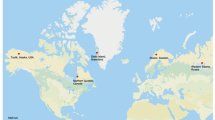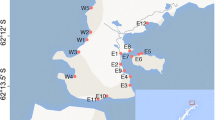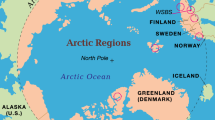Abstract
Eight bimonthly sediment core samples (n = 6) were collected, to a depth of 64 cm, from the hyporheic zone of a springbrook in southern Ontario, Canada. Sediment cores were divided into three to four sections, and organic matter was subdivided into six different categories. Twigs were the most common substrate, followed by roots, cedar leaves, wood, grass, and deciduous leaves. The contributions of deciduous and cedar leaves declined with depth, whereas that of wood increased. On each sampling date and from each section, three randomly chosen substrates >3 cm were examined for conidia of aquatic hyphomycetes. The number of identified species significantly decreased with depth, and was highest on deciduous leaves and lowest on wood. Season had no significant effect on species numbers. DNA from substrates was extracted, amplified with fungal primers, and differentiated into phylotypes with denaturing gradient gel electrophoresis (DGGE). Absence/presence patterns of phylotype were significantly affected by season but not by section level. Both season and section level significantly affected relative densities of the bands of the 10 most common phylotypes. Our data suggest that aquatic hyphomycetes and other fungi readily disperse within the hyporheic zone, and that their relative scarcity in this habitat is due to a lack of suitable substrates.


Similar content being viewed by others
References
Allan, JD (1995) Stream Ecology. Structure and Function of Running Waters. Chapman & Hall, New York
Anderson, MJ (2003) CAP: A FORTRAN Computer Program for Canonical Analysis of Principal Coordinates. Department of Statistics, University of Auckland, New Zealand
Anderson, MJ, Willis, TJ (2003) Canonical analysis of principal coordinates: a useful method of constrained ordination for ecology. Ecology 84: 511–525
Bärlocher, F (1992) Community organization. In: Bärlocher F (Ed.) The Ecology of Aquatic Hyphomycetes. Springer-Verlag, New York, pp 38–76
Bärlocher, F (2000) Water-borne conidia of aquatic hyphomycetes: seasonal and yearly patterns in Catamaran Brook, New Brunswick, Canada. Can J Bot 78: 157–167
Bärlocher, F, Murdoch, JH (1989) Hyporheic biofilms—a potential food source for hyporheic animals. Hydrobiologia 184: 61–67
Boggs, S (1987) Principles of Sedimentology and Stratigraphy. Merrill Publishing, Ohio
Boulton, AJ (1993) Stream ecology and surface-hyporheic hydrologic interchange: implications, techniques and limitations. Aust J Mar Freshw Res 44: 553–564
Eichem, AC, Doss, WK, Tate, CM, Edler, C (1993) Microbial decomposition of elm and oak leaves in a karst aquifer. Appl Environ Microbiol 59: 3592–3596
Ellis, BK, Stanford, JA, Ward, JV (1998) Microbial assemblages and production in alluvial aquifers of the Flathead River, Montana, USA. J N Am Benthol Soc 17: 382–402
Fiebig, DM, Lock, MA (1991) Immobilization of dissolved organic matter from groundwater discharging through the stream bed. Freshw Biol 26: 45–55
Field, JI, Webster, J (1983) Anaerobic survival of aquatic fungi. Trans Br Mycol Soc 81: 365–369
Fraser, BG, Williams, DD (1998) Seasonal boundary dynamics of a groundwater/surface-water ecotone. Ecology 79: 2019–3031
Gessner, MO, Bärlocher, F, Chauvet, E (2003) Qualitative and quantitative analyses of aquatic hyphomycetes in streams. Fungal Divers Res Ser 10: 127–157
Gönczöl, J, Révay, A (1993) Further studies on fungal colonization of twigs in the Morgó-stream. Nova Hedwig 56: 531–542
Gönczöl, J, Révay, A (1997) Spatial dynamics of fungal populations (Hyphomycetes) on submerged corticated twigs. Nova Hedwig 64: 553–565
Grimm, NB, Fisher, SG (1984) Exchange between surface and interstitial water: implications for stream metabolism and nutrient cycling. Hydrobiologia 111: 219–228
Gulis, V (2001) Are there any substrate preferences in aquatic hyphomycetes? Mycol Res 105: 1088–1093
Hendricks, SP (1993) Microbial ecology of the hyporheic zone: a perspective integrating hydrology and biology. J N Am Benthol Soc 2: 70–78
Hogg, ID, Williams, DD (1996) Responses of stream invertebrates to a global-warming thermal regime: an ecosystem-level manipulation. Ecology 77: 395–407
Hynes, HBN (1975) The stream and its valley. Verh Int Ver Theor Angew Limnol 19: 1–15
Jones, JB (1997) Benthic organic matter storage in streams: influence of detrital import and export, retention mechanisms and climate. J N Am Benthol 16: 109–119
Krauss, G, Sridhar, KR, Jung, K, Wennrich, R, Ehrman, J, Bärlocher, F (2003) Aquatic hyphomycetes in polluted groundwater habitats of Central Germany. Microb Ecol 45: 329–339
Legendre, L, Legendre, P (1983) Numerical Ecology. Elsevier, Amsterdam
Madsen, EL, Ghiorse, WC (1993) Groundwater microbiology: subsurface ecosystem processes. In: Ford T (Ed.) Aquatic Microbiology: An Ecological Approach. Blackwell, Cambridge, MA, pp 167–213
May, LA, Smiley, B, Schmidt, MG (2001) Comparative denaturing gradient gel electrophoresis of fungal communities associated with whole plant corn silage. Can J Microbiol 47: 829–841
McManus, J (1988) Grain size determination and interpretation. In: Tucker M (Ed.) Techniques in Sedimentology. Blackwell Scientific, Oxford, pp 63–85
Muyzer, G, de Waal, EC, Uitterlinden, AG (1993) Profiling of complex microbial populations by denaturing gradient gel electrophoresis analysis of polymerase chain reaction-amplified genes coding for 16S rRNA. Appl Environ Microbiol 59: 695–700
Nikolcheva, LG, Bärlocher, F (2004) Taxon-specific primers reveal unexpectedly high diversity during leaf decomposition in a stream. Mycol Prog 3: 41–50
Nikolcheva, LG, Bärlocher, F (2005) Seasonal and substrate preferences of fungi colonizing leaves in streams: traditional vs. molecular evidence. Environ Microbiol 7: 270–280
Nikolcheva, LG, Cockshutt, AM, Bärlocher, F (2003) Determining diversity of freshwater fungi on decaying leaves: comparison of traditional and molecular approaches. Appl Environ Microbiol 69: 2548–2554
Nikolcheva, LG, Bourque, T, Bärlocher, F (2005) Fungal diversity during initial stages of leaf decomposition in a stream. Mycol Res 109: 246–253
Schadt, CW, Martin, AP, Lipson, DA, Schmidt, SK (2003) Seasonal dynamics of previously unknown fungal lineages in tundra soil. Science 301: 1359–1361
Shearer CA (1992) The role of woody debris. In: Bärlocher F (Ed.) The Ecology of Aquatic Hyphomycetes. Springer-Verlag, New York, pp 77–98
Shearer, CA, von Bodman, SB (1983) Patterns of occurrence of ascomycetes associated with decomposing twigs in a midwestern stream. Mycologia 75: 518–530
Sinclair, JL, Ghiorse, WC (1989) Distribution of aerobic bacteria, protozoa, algae, and fungi in deep subsurface sediments. Geomicrobiology 7: 15–31
Storey, RG, Fulthorpe, RR, Williams, DD (1999) Perspectives and predictions on the microbial ecology of the hyporheic zone. Freshw Biol 41: 119–130
Suberkropp, K (1992) Interactions with invertebrates. In: Bärlocher F (Ed.) The Ecology of Aquatic Hyphomycetes. Springer-Verlag, New York, pp 118–134
Triska, FJ, Jackman, AP, Duff, JH, Avanzino, RJ (1994) Ammonium sorption to channel and riparian sediments: a transient storage pool for dissolved inorganic nitrogen. Biogeochemistry 26: 67–83
Webster, JR, Benfield, EF (1986) Vascular plant breakdown in freshwater ecosystems. Annu Rev Ecol Syst 17: 567–594
Williams, DD (1993) Nutrient and flow vector dynamics at the hyporheic-groundwater interface and their effects on the interstitial fauna. Hydrobiologia 251: 185–198
Williams, DD, Hogg, ID (1988) The ecology and production of invertebrates in a Canadian coldwater spring. Holarct Ecol 11: 41–54
Acknowledgments
Financial support by Natural Sciences and Engineering Research Council of Canada (F. Bärlocher and D. D. Williams), and through a Rice Memorial Graduate Fellowship (L. G. Nikolcheva), is gratefully acknowledged. Parts of this study were carried out with equipment from the Mount Allison Coastal Wetlands Institute.
Author information
Authors and Affiliations
Corresponding author
Rights and permissions
About this article
Cite this article
Bärlocher, F., Nikolcheva, L.G., Wilson, K.P. et al. Fungi in the Hyporheic Zone of a Springbrook. Microb Ecol 52, 708–715 (2006). https://doi.org/10.1007/s00248-006-9102-4
Received:
Accepted:
Published:
Issue Date:
DOI: https://doi.org/10.1007/s00248-006-9102-4




